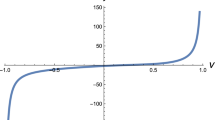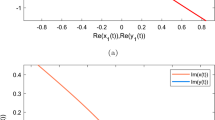Abstract
It is usually essential to reveal the relationship between continuous-time systems and discrete-time ones. First, a discrete-time recurrent neural network is presented by the Euler scheme in this paper. Then, the time step size is set to a bifurcation parameter and frequency domain approach is adopted for Hopf bifurcation analysis. Moreover, the periodic solutions are obtained by the harmonic balance method; then the stability conditions are presented. The critical step size is determined with which the discrete-time recurrent neural network can inherit the stable state of the continuous-time one. Finally, one numerical example of the discrete-time recurrent neural network is given to support the theoretical analysis.








Similar content being viewed by others
Data availability
The datasets analyzed during the current study are included in this article.
References
Hopfield, J.J.: Neurons with graded response have collective computational properties like those of two-state neurons. Proc. Natl. Acad. Sci. USA 81(10), 3088–3092 (1984)
Suzuki, K., Abe, H., MacMahon, H., Doi, K.: Image-processing technique for suppressing ribs in chest radiographs by means of massive training artificial neural network (MTANN). IEEE Trans. Med. Imaging 25(4), 406–416 (2006)
Chen, Y.S., Jiang, H.L., Li, C.Y., Jia, X.P., Ghamisi, P.: Deep feature extraction and classification of hyperspectral images based on convolutional neural networks. IEEE Trans. Geosci. Remote Sens. 54(10), 6232–6251 (2016)
Abu-Khalaf, M., Lewis, F.L.: Nearly optimal control laws for nonlinear systems withsaturating actuators using a neural network HJB approach. Automatica 41(5), 779–791 (2005)
Vrabie, D., Lewis, F.: Neural network approach to continuous-time direct adaptive optimal control for partially unknown nonlinear systems. Neural Netw. 22(3), 237–246 (2009)
Yang, X.S., Lam, J., Ho, D.W.C., Feng, Z.G.: Fixed-time synchronization of complex networks with impulsive effects via nonchattering control. IEEE Trans. Autom. Control 62(11), 5511–5521 (2017)
Azad, H.B., Mekhilef, S., Ganapathy, V.G.: Long-term wind speed forecasting and general pattern recognition using neural networks. IEEE Trans. Sustain. Energy 5(2), 546–553 (2014)
Liu, M.Y., Liu, H., Chen, C.: Enhanced skeleton visualization for view invariant human action recognition. Pattern Recognit. 68, 346–362 (2017)
Jia, F., Lei, Y.G., Lin, J., Zhou, X., Lu, N.: Deep neural networks: a promising tool for fault characteristic mining and intelligent diagnosis of rotating machinery with massive data. Mech. Syst. Signal Pr. 72–73, 303–315 (2016)
Boonsatit, N., Rajchakit, G., Sriraman, R., Lim, C.P., Agarwal, P.: Finite/fixed-time synchronization of delayed Clifford-value recurrent neural networks. Adv. Differ. Equ. 2021(1), 276 (2021)
Rajchakit, G., Sriraman, R., Boonsatit, N., Hammachukiattikul, P., Lim, C.P., Agarwal, P.: Exponential stability in the Lagrange sense for Clifford-valued recurrent neural networks with time delays. Adv. Differ. Equ. 2021(1), 256 (2021)
Rajchakit, G., Sriraman, R., Boonsatit, N., Hammachukiattikul, P., Lim, C.P., Agarwal, P.: Global exponential stability of Clifford-valued neural networks with time-varying delays and impulsive effects. Adv. Differ. Equ. 2021(1), 208 (2021)
Rajchakit, G., Agarwal, P., Sriraman, R.: Stability Analysis of Neural Networks. Springer, Singapore (2021)
Yu, W.W., Cao, J.D., Chen, G.R.: Stability and Hopf bifurcation of a general delayed recurrent neural network. IEEE Trans. Neural Netw. 19(5), 845–854 (2008)
Hassard, B.D., Kazarinoff, N.D., Wan, Y.H.: Theory and Applications of Hopf Bifurcation. Cambridge University Press, Cambridge (1981)
Zeng, X.C., Xiong, Z.L., Wang, C.J.: Hopf bifurcation for neutral-type neural network model with two delays. Appl. Math. Comput. 282, 17–31 (2016)
Karaoǧlu, E., Yılmaz, E., Merdan, H.: Hopf bifurcation analysis of coupled two-neuron system with discrete and distributed delays. Nonlinear Dyn. 85(2), 1039–1051 (2016)
Wang, Z., Li, L., Li, Y.X., Cheng, Z.S.: Stability and Hopf bifurcation of a three-neuron network with multiple discrete and distributed delays. Neural Process. Lett. 48(3), 1481–1502 (2018)
He, Z.M., Lai, X.: Bifurcation and chaotic behavior of a discrete-time predator-prey system. Nonlinear Anal. Real World Appl. 12(1), 403–417 (2011)
Allwright, D.J.: Harmonic balance and the Hopf bifurcation. Math. Proc. Camb. Philos. Soc. 82(3), 453–467 (1977)
Mees, A.I., Chua, L.O.: The Hopf bifurcation theorem and its applications to nonlinear oscillations in circuits and systems. IEEE Trans. Circuits Syst. 26(4), 235–254 (1979)
Moiola, J.L., Chen, G.R.: Hopf Bifurcation Analysis: a Frequency Domain Approach. World Scientific, Singapore (1996)
Gentile, F.S., Moiola, J.L., Chen, G.R.: Frequency-Domain Approach to Hopf Bifurcation Analysis: Continuous Time-Delayed Systems. World Scientific, Singapore (2019)
Gentile, F.S., Moiola, J.L.: Hopf bifurcation analysis of distributed delay equations with applications to neural networks. Int. J. Bifurcat. Chaos 25(11), 1550156 (2015)
Yu, J.C., Peng, M.S.: Local Hopf bifurcation analysis and global existence of periodic solutions in a gene expression model with delays. Nonliear Dyn. 86(1), 245–256 (2016)
D’Amico, M.B., Moiola, J.L., Paolini, E.E.: Hopf bifurcation in discrete–time systems via a frequency domain approach. In: 2000 2nd International Conference. control of oscillations and chaos. Proceedings (Cat. No.00TH8521), St. Petersburg, Russia, pp. 290–293 (2000)
D’Amico, M.B., Moiola, J.L., Paolini, E.E.: Hopf bifurcation for maps: a frequency-domain approach. IEEE Trans. Autom. Control 49(3), 281–288 (2002)
D’Amico, M.B., Paolini, E.E., Moiola, J.L.: Stability analysis of degenerate Hopf bifurcations for discrete-time systems. Lat. Am. Appl. Res. 33(4), 413–418 (2003)
Zeng, L., Wang, J.W.: Bifurcation analysis of maps with delay in nonlinear term via a frequency–domain approac. In: 2011 IEEE Power Engineering and Automation Conference, Wuhan, China, pp. 30–33 (2011)
Phillips, C.L., Nagle, H.T., Chakrabortty, A.: Digital Control System Analysis and Design, 4th edn. Pearson, Edinburgh (2015)
Macfarlane, A.G.J., Postlethwaite, I.: The generalized Nyquist stability criterion and multivariable root loci. Int. J. Control 25(1), 81–127 (1977)
Edmunds, J.M.: Characteristic gains, characteristic frequencies and stability. Int. J. Control 29(4), 669–706 (1979)
Sauer, T.: Numerical Analysis, 2nd edn. Pearson, Boston (2011)
Podlubny, I.: Fractional Differential Equations. Academic Press, San Diego (1999)
Wu, G.C., Baleanu, D.: Discrete fractional logistic map and its chaos. Nonlinear Dyn. 75(1–2), 283–287 (2014)
Wu, G.C., Abdeljawad, T., Liu, J.L., Baleanu, D., Wu, K.T.: Mittag-Leffler stability analysis of fractional discrete-time neural networks via fixed point technique. Nonlinear Anal. Model. Control 24(6), 919–936 (2019)
Wang, B., Jahanshahi, H., Volos, C., Bekiros, S., Khan, M.A., Agarwal, P., Aly, A.A.: A new RBF neural network-based fault-tolerant active control for fractional time-delayed systems. Electronics 10(12), 1501 (2021)
Funding
This work was partially supported by National Natural Science Foundation of China (NSFC) (Grant No. 62076141), Natural Science Foundation of Chongqing Science and Technology Bureau (Grant No. cstc2019jcyj-msxmX0020), and Graduate Student Innovation Program of Chongqing University of Technology (Grant No. gzlcx20223305).
Author information
Authors and Affiliations
Corresponding author
Ethics declarations
Conflicts of interest
The authors declare that they have no conflict of interests.
Ethical Statement
The authors declare that they comply with ethical standards.
Additional information
Publisher's Note
Springer Nature remains neutral with regard to jurisdictional claims in published maps and institutional affiliations.
Appendix
Appendix
The direction of half-line staring at \(-1+{\textbf {i}}0\) can be obtained as \(\varepsilon = l_{0}\Big (l_{1}{\textrm{e}^{-{\textbf {i}}\omega \tau _{1}}}+l_{2}{\textrm{e}^{-{\textbf {i}}\omega \tau _{2}}}+l_{3} {\textrm{e}^{-{\textbf {i}}\omega ( \tau _{1}-1 ) }}+ l_{4}{\textrm{e}^{-{\textbf {i}}\omega ( \tau _{2}-1 ) }}+l_{5} {\textrm{e}^{-{\textbf {i}}\omega ( \tau _{1}-2 ) }}+l_{6} {\textrm{e}^{-{\textbf {i}}\omega ( \tau _{2}-2 ) }}+ l_{7}{\textrm{e}^{-{\textbf {i}}\omega ( \tau _{1}-3 ) }}+ l_{8} {\textrm{e}^{-{\textbf {i}}\omega ( \tau _{2}-3 ) }} \Big ) \Big / ( (6h-5)(\cos \omega -1)+4h^{2} ) ( {\textrm{e}^{{\textbf {i}}\omega }}-1+h ) ^{2} ( {\textrm{e}^{{\textbf {i}}\omega }}h-{\textrm{e}^{{\textbf {i}}\omega }}+1) ( {\textrm{e}^{{\textbf {i}}\omega }}-1+2\,h ) \), where
Rights and permissions
Springer Nature or its licensor (e.g. a society or other partner) holds exclusive rights to this article under a publishing agreement with the author(s) or other rightsholder(s); author self-archiving of the accepted manuscript version of this article is solely governed by the terms of such publishing agreement and applicable law.
About this article
Cite this article
Hou, HS., Luo, C., Zhang, H. et al. Frequency domain approach to the critical step size of discrete-time recurrent neural networks. Nonlinear Dyn 111, 8467–8476 (2023). https://doi.org/10.1007/s11071-023-08278-0
Received:
Accepted:
Published:
Issue Date:
DOI: https://doi.org/10.1007/s11071-023-08278-0




